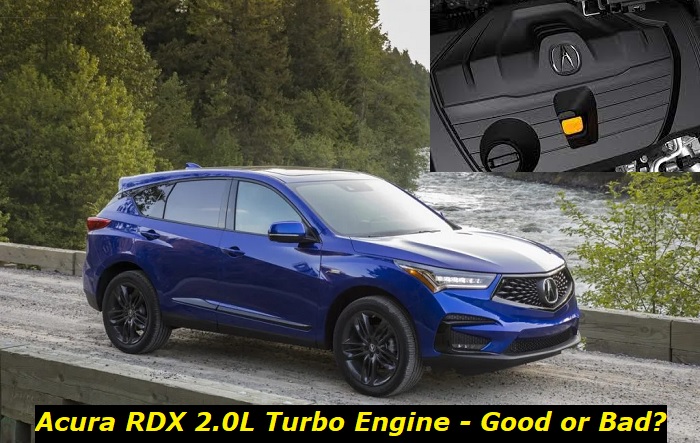In 2023, you can still buy the third-generation Acura RDX in Honda and Acura showrooms across the United States. The new generation, or better say a facelifted version, is likely to arrive at the beginning of 2024. But even if you are reading this article after the new-gen RDX started selling in the US, all the information about its 2.0L Turbo engine is still accurate and up-to-date because it's not going to be changed or modified much.
Today, we are going to tell you more about the Acura RDX 2-liter turbocharged K20C4 engine which is the only option for the model now, about its specs and also common problems. We'll look at its durability and decide whether this engine is better than the engines in other small luxury SUVs on the market and whether you should opt for it or not.

Key specs and my opinion about the engine
- Production years:2018-now
- Average lifespan of K20C4:200,000-230,000 miles
- Fuel supply type:direct injection
- Power range:252-272 hp
- Fuel efficiency:good
- Engine block material:aluminum
- Engine reliability score:high
- The most common problems:leaky seals, turbo problems, chain premature failure, engine mount issues.
What about the Acura RDX 2.0 Turbo engine? Is it good?
Given it's a luxury SUV from a luxury brand owned by Honda, we have no doubt that the engine is really good. But in this article, we are going to show not only the bright sides of this powerplant. We'll show you all the downsides so that you were ready to face some of the most common difficulties and mishaps that can happen.
The 2-liter turbo engine in the new Acura RDX is actually the K20C4 engine by Honda that is fitted with a turbocharger and currently, this is the only option for all RDX trims. The good point is that the engine is pretty simple in terms of technology and not expensive to own and maintain. Also, it's relatively reliable and good in the long run.
Here's what you might want to know about the 2-liter engine in the RDX:
- exactly this modification of the K-Series engine (with different ECU tune and different power) was used in the Honda Accord 2018-2022, so it's pretty popular and common in the US;
- the engine is the 4-cylinder turbocharged powerplant that offers 272 horsepower and 280 lb-ft of torque - not a lot but enough for the vehicle;
- the series K20C has been manufactured since 2015 and has been used in numerous Honda and Acura models, we know a lot about its common issues;
- direct injection is featured here, so the problems with carbon buildup will follow you after 50-60 thousand miles;
- the VTEC system is presented here on the exhaust valves, it is meant to improve engine work but it also adds some problems to high-mileage engines;
- the block and the head are both aluminum, so once the engine block gets extensive wear, there is no chance to repair it;
- the engine is not very complicated in terms of technologies used to build it, so it could be classified as reliable and reasonable taking into account maintenance costs;
- the engine is coupled with the 10-speed automatic transmission, thank goodness it's not CVT, so at least we have some hope for reliability.
We should say that the engine still has some common issues that are usual for any K-Series engine but it's really good in comparison with other premium-SUV engines that can only drive 150K miles before they are dead. This K20C4 engine is not going to cause you a lot of problems but we should face it - it's not going to be that fun to drive! Take a Mercedes GLC or the Genesis GV70 and you'll see many more interesting engines on offer.
But still, Acura chose fuel economy and reliability as its main arguments for buyers and they won. In 2021, for example, the RDX sold over 57,000 SUVs in the US while the GLC sold 51,000 and the Genesis could get only a little more than 10,000 units. So, why did so many Americans choose this vehicle? Let's see.
What's the durability of the 2.0L Turbo engine in the Acura RDX?
You can expect the K204C engine to last at least 200,000 miles. It's an outstanding result as for the luxury SUV - we haven't seen anything better than 160K miles in all competitors of the RDX. So, yes, Acura offers a really reliable and good engine although it's not as powerful as many competitors on the market.
Of course, durability is not guaranteed. You can forget about oil changes, buy cheap parts, go to cheap bad repair stations, and kill your RDX sooner than you may expect. This engine, as any other modern engine, needs very high-quality maintenance which is going to cost you a lot of money. But this money will pay off with a long and problem-free ride.
The RDX 2.0L Turbo engine is a kind of compromise between high power and good durability and reliability. It doesn't offer you a lot of power but it still goes fast and accelerates as crazy. On the other hand, it offers you more miles than any other luxury-SUV engine on the market. So, this powerplant may be really worth considering if you are still unsure what SUV model you would like to buy.
What are the most common problems with the K204C engine?
The K-Series engines are really good and not problematic. But still, they have some common issues that occur now and then. The good news: you won't need to go to the dealership too often until you have a really high-mileage vehicle. All major problems start accumulating and showing up after you drive about 100,000 miles.
Some fatal problems usually appear when the engine hits the 200,000-mile mark unless the engine wasn't maintained well.
Here are some common issues you should keep an eye at:
1. Seals tend to leak
Right before the vehicle hits the 100,000-mile mark, you may notice some leaks from the engine. Oil may start leaking through the crankshaft seal or even through the head cover seal. This problem has one expensive solution: you should have the seals replaced by professionals. If you noticed some oil drops under the vehicle, you shouldn't drive like this for weeks or months. Take your Acura to the dealership.
Extensive leaks may lead to low oil levels. This, in turn, will accelerate engine wear and may even kill your engine block if overlooked badly.
2. Turbocharger issues
After 100,000 miles or so you will notice that the vehicle may accelerate too slowly and/or some black smoke comes out of the pipe when you start the engine after the night. These are the first symptoms of a tired turbocharger. Just have it inspected by professionals. Sometimes, you can have it repaired, but usually, replacement is the best solution.
3. Chain rattle at high mileage
Once you repair all those 100K-mile problems, the chain may start rattling. The timing chain is not really cheap to replace but you will have to do it approximately in the middle of the engine lifespan. So, 110,000 miles is a good milestone for chain replacement, it won't go longer than 120K miles, but it's always better to have it replaced before it started rattling.
Remember that the chain should be replaced along with the water pump, tensioner, and sometimes other accessories.
4. Mount problems
This issue can get on your nerves at any mileage, so just keep an eye on vibrations and the overall quality of engine work. If it vibrates badly or rattles, it may be the mount. Engine mounts are a big problem of Honda and Acura engines, so this is the first thing you should check if you feel some symptoms. Also, this is one of the cheapest common problems on the list, so it comes in the last place.
What should I do to let my 2.0 Turbo engine in the RDX live longer?
The best strategy with your new Acura RDX is to follow the maintenance plan that is provided by the manufacturer up until the warranty period is over or the vehicle hits the warranty top mileage mark. After that, you should change the oil and filters more often and also have the vehicle inspected regularly.
Pay attention to any rattle or vibration. This may be a clear sign that your engine needs an urgent repair (timing chain or engine mount). Also, be careful with any detected leaks. Whatever fluid leaks, just have the vehicle diagnosed and repaired until the leak caused some more major problems.
Never buy bad fuel and forget about aftermarket parts or fluids. OEM Acura products are your choice if you want durability from your RDX.
Final words
You may see that the 2-liter turbo engine in the new Acura RDX is not bad at all. It's better and more reliable than many other competitors on the market. But it's a loser if you compare power and speed. Also, this engine can save up some money for you at the fuel pump because its consumption is more than reasonable.
If you add up all the advantages and also go to test drive this car and feel OK in it, this is one of the best options to go for in the market of small luxury SUVs, in our opinion.
About the authors
The CarAraC research team is composed of seasoned auto mechanics and automotive industry professionals, including individuals with advanced degrees and certifications in their field. Our team members boast prestigious credentials, reflecting their extensive knowledge and skills. These qualifications include: IMI: Institute of the Motor Industry, ASE-Certified Master Automobile Technicians; Coventry University, Graduate of MA in Automotive Journalism; Politecnico di Torino, Italy, MS Automotive Engineering; Ss. Cyril and Methodius University in Skopje, Mechanical University in Skopje; TOC Automotive College; DHA Suffa University, Department of Mechanical Engineering






Add comment